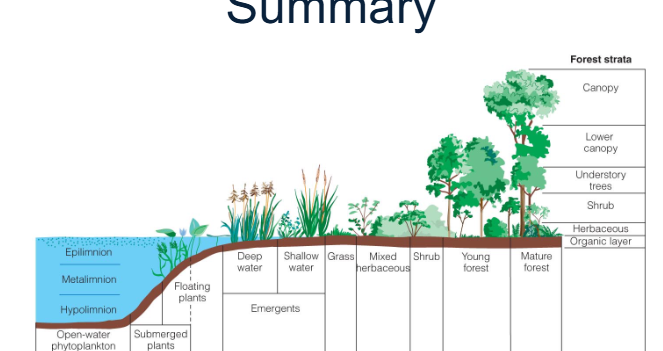Environmental Heterogeneity
1/9
There's no tags or description
Looks like no tags are added yet.
Name | Mastery | Learn | Test | Matching | Spaced |
|---|
No study sessions yet.
10 Terms
Environmental Heterogeneity(variation)
• Climate is the part of the physical (abiotic) environment having the greatest impact on organisms
– Weather = combination of temperature, humidity, precipitation, wind, cloudiness at a specific place and time
– Climate = long-term average pattern of weather
• Earth’s atmosphere intercepts solar radiation & Earth’s rotation and movement
generate prevailing wind & ocean currents
→ generates global weather patterns
→ results in environmental heterogeneity(=variability in abiotic factors across
space)
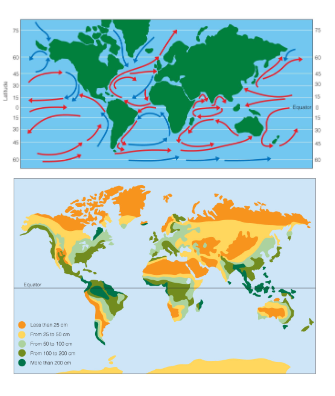
Microclimate
• Weather patterns differ at different spatial scales:
• Global & regional climate patterns determine the large-scale distribution & abundance of organisms
– Local climate does not match climate patterns in the larger region (e.g. Winnipeg vs. Manitoba)
• local -- microclimate patterns are actual environmental conditions experienced by
organisms...
Global → Regional → Local → Micro
→ Our Focus!

Aquatic environment
Dominant environment on Earth
~ 75 % of the planet’s surface is water
• Low degree of microclimate variability in time and space (compared to terrestrial), think about on land, on a hot day when you stand underneath a tree in the shade, it’s much cooler than if you were to stand in the sun. That doesn’t really happen underwater.
• Divided by salinity: saltwater and freshwater
• Divided by depth
– Solar radiation that hits water:
1. Reflected back into atmosphere
2. Absorbed or reflected by suspended particles (alive/dead/abiotic solids)
3. Absorbed by water
Solar radiation declines exponentially with depth
→ Distinct vertical profiles of light, temperature, oxygen, pressure, etc.
Decline in solar radiation with depth has had a major influence on the evolution of aquatic organisms.
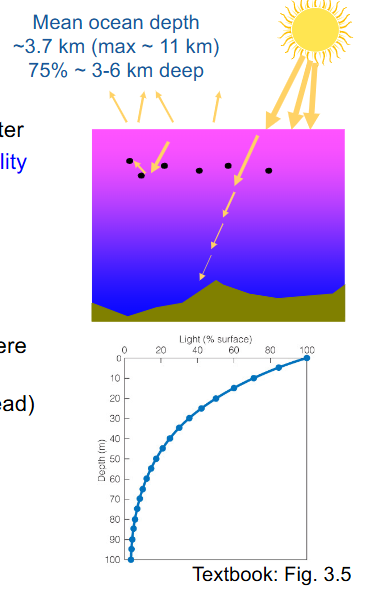
Aquatic Environment - Light
• Direct impact: plants
– Plants require sunlight for photosynthesis
• Plants are restricted to top 100m
• Indirect impact: animals
– Herbivores are restricted to depths where plants reside
This variation in an abiotic factor (light) affects the distribution of herbivores in the water.
– Animals inhabiting deep water (> 200 m) have adaptations:
• Lack pigment
• Large eyes (maximum light-gathering ability)
• Organs that produce light (bioluminescence)
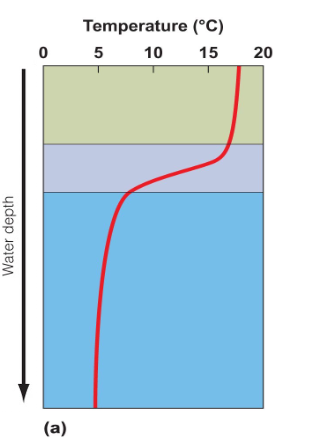
Aquatic Environment - Temperature
• Exponential decline in solar radiation with depth → temperature declines with
depth
– thermocline = region of most rapid temperature change (grey area on graphic)
• After thermocline, temperature continues to decline with depth but at a slower rate
– Some form of thermal stratification occurs in all open bodies of water, different parts /different strata in the water column, typically seen in every water body.
– Mixing of the water column can break down this gradient (e.g. winds, currents, seasonal)
• as water cools, it becomes more dense until 4ºC (maximum density)
→ below 0-4ºC - less dense
Shallow Lakes (e.g. Lake Winnipeg)
• Fall: surface waters cool, become more dense, sink (repeatedly), forces cooler bottom temperatures up to the surface, mixes all the water up, eventually same temp at the surface and at the bottom
– creates mixing – ‘fall turnover’
Can see the difference season water temperatures on the graph. In fall it is all the same because of the turnover.
• Winter: surface waters < 4ºC (less dense) – keeps cold water at surface (freezes) → warmer water below – allows organisms to survive in winter! Cooler water at the surface is less dense so it flows, more dense warmer water stays warmer below where organisms can live.
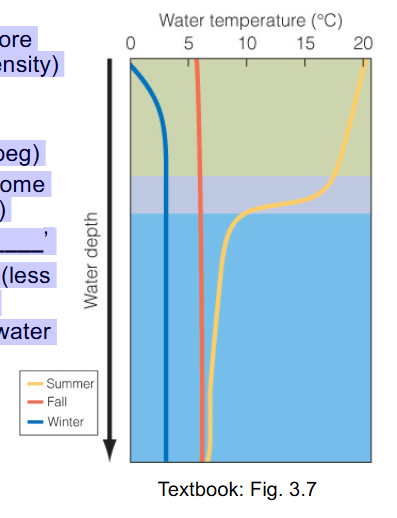
Aquatic Environment - Oxygen
• Oxygen diffuses from the atmosphere into aquatic environments through surface waters
• Oxygen is produced by plants during photosynethesis (only in surface waters)
– Restricts high concentrations of oxygen to surface waters
– Limits respiration and metabolic activity of animals
– Mixing of water column (fall) can break down gradient
See the decline in summer oxygen content due to decomposers on the sea or lake bed using up oxygen. Fall we see the affect of the turnover. In the winter we see the same decmoposers affect. We see the diffusion which can be limited due to ice.
Shallow Lakes (e.g. Lake Winnipeg)
- Algal blooms → algae die, sink, decomposers use up all O 2 → ‘dead zones’ (low O 2), really big algal blooms feed decomposers using up ALL oxygen in the lake and making it annoxic and things die.
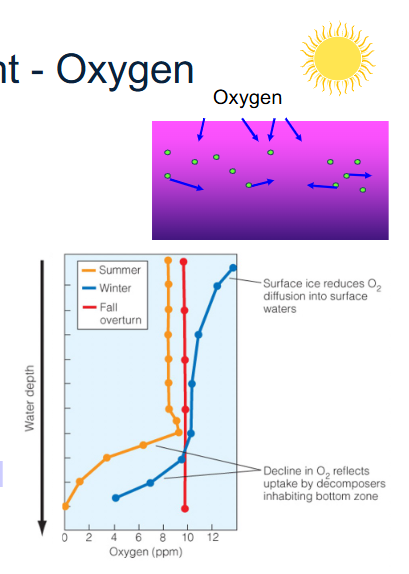
Terrestrial environemnt
• Higher degree of microclimate variability in time and space (compared to aquatic)
• Greatest constraint for terrestrial organisms is desiccation (drying out)
~ living cells contain 75 - 95 % water
• soil is the foundation upon which all terrestrial life depends
– Medium for plant growth
→ provides vertical structure for animals
– Controls the fate of water in terrestrial environments, think of leaching and infiltration
– Provides habitat for decomposers (~nature’s recycling system)
maintaining water balance has had a major influence on evolution of terrestrial organisms.
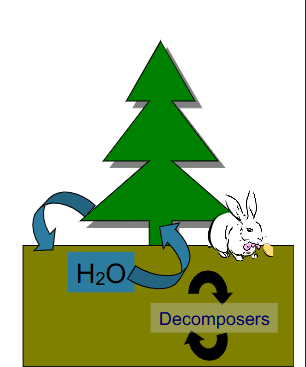
Terrestrial environment: moisture-holding capacity of soil
• Moisture-holding capacity of the soil determines availability of water &
chemical elements dissolved in soil water
What causes variation in the soil moisture-holding capacity?
1. Climate- directly influences the physical & chemical reactions in the
soil and water availability. What does the soil experience over the long term. Affects physical and chemical reactions, how much nutrients are running off into the soil, how much water is available.
2. Type of parent material from which soil develops
• Physical & chemical characteristics determine properties of soil (e.g.
grain size, acidity, minerals)
3. Topography– sloped vs level ground, water draining down to lower elavetions, where does the water table intersect, creates different microclimates too, different elevations experience different conditions
4. aspect– north vs south-facing
• Differ in exposure to solar radiation due to angle of sun (~temperature), what areas are getting the most/least light. Warm, dry, or cold, wet
In a small scale, we see alot of variabitliy in abiotic factors they experience
5. Presence/absence and type of vegetation
• Vegetation alters microclimates:
• Light (via shading), higher at top of the tree
• Temperature (via shading), vegetation shading the soil changes its temperature, also think albedo
• Moisture (via use)
• Wind movement
• Structure → habitat for animals
look at the clear cut, we change the amount of moisture in the soil, the soil is scorched, we change the abiotic factors available
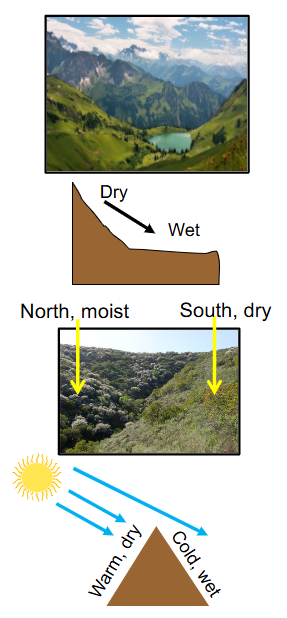
Vegetation - habitat for animals
different bird species on x axis, what microclimate/habitat on the tree do the bird species depend on?
Clear cutting eliminates habitat for many different species.
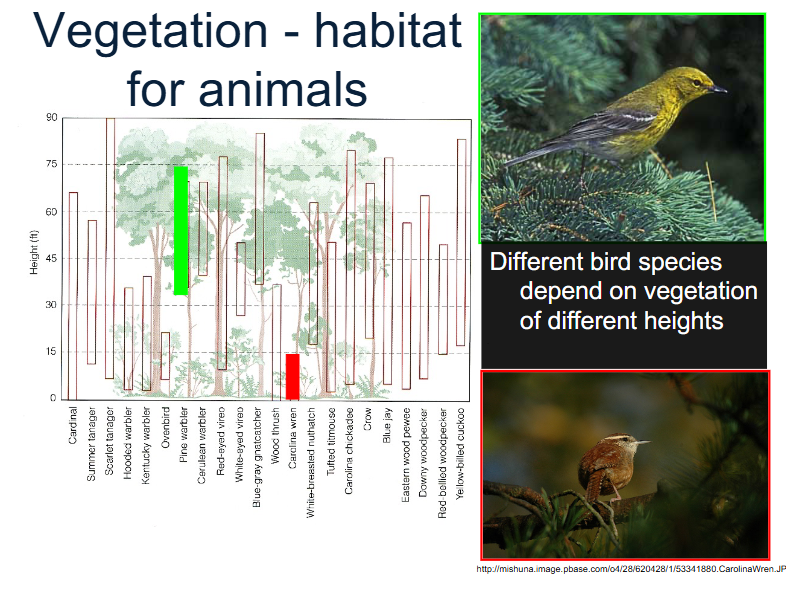
Summary
• encounter a range of distinct microclimates along the Earth’s surface (= environmental heterogeneity)
– Plant and animal species adapt to a specific range of abiotic conditions that vary over space (and time)
Look at the environmental heterogeneity in the image, so many different microclimates to live in
– physiological ecology – how an individual responds to environmental conditions (abiotic) and adaptations of a population over generations
